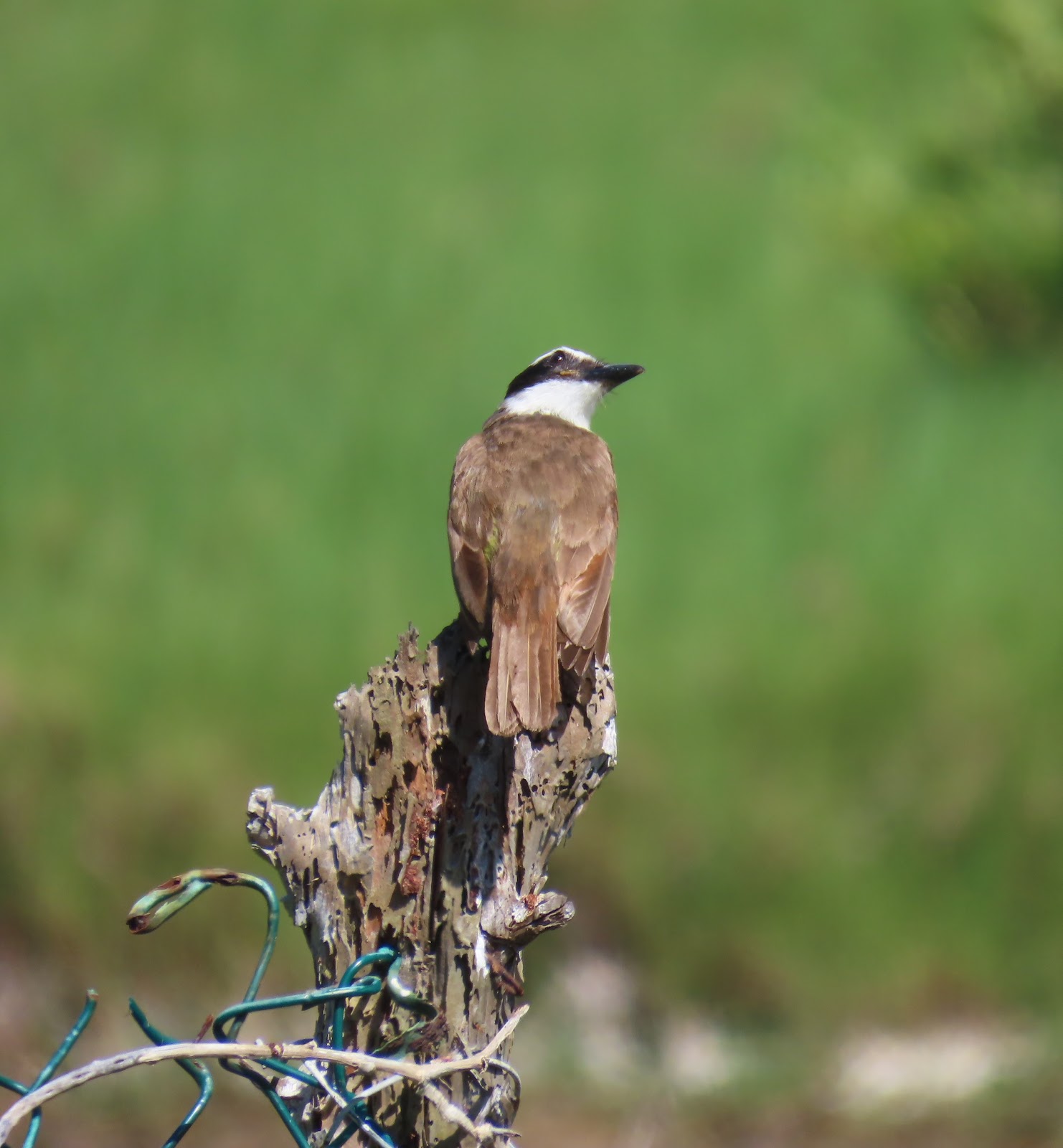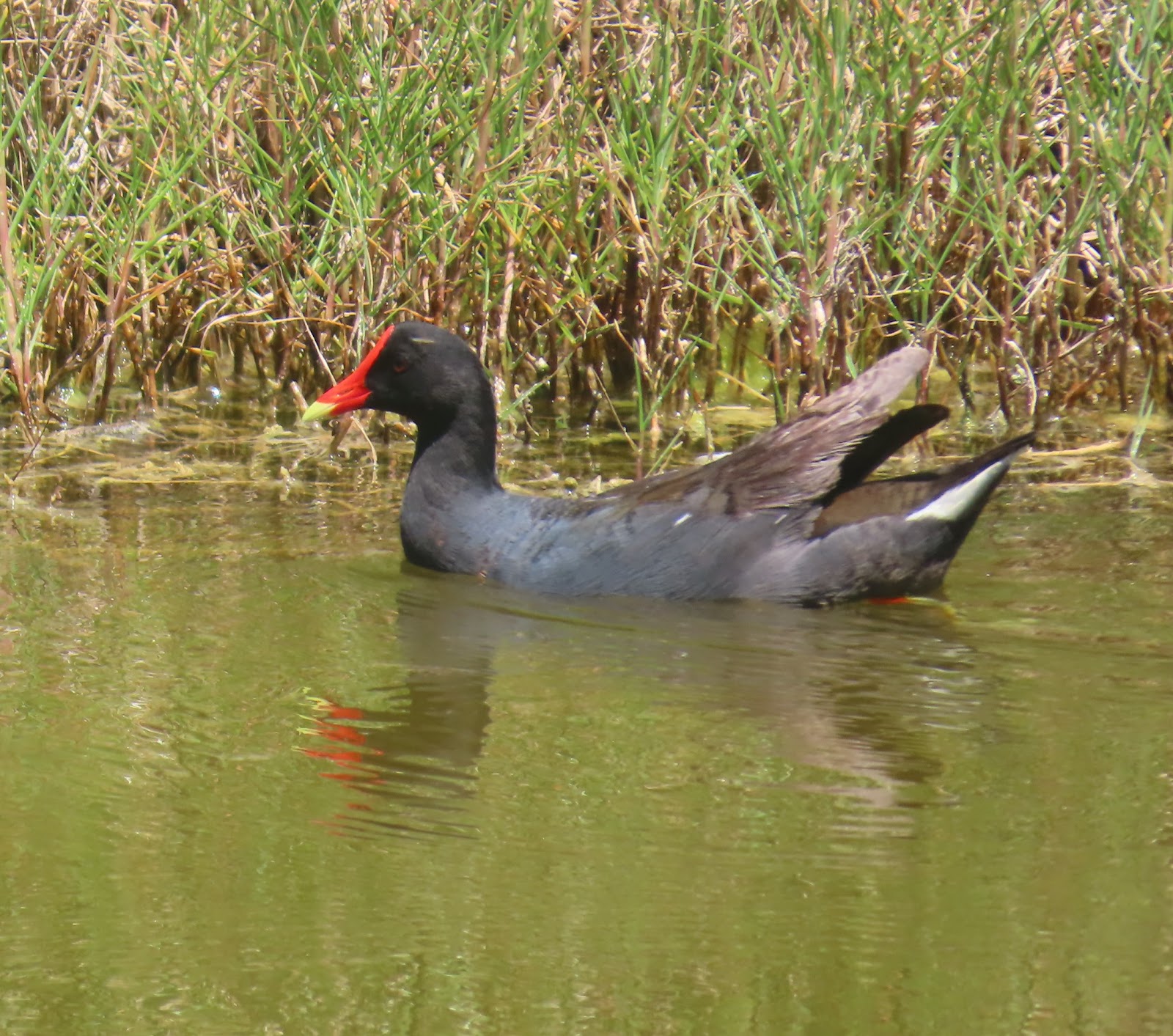 |
| WHITE-TAILED TROPICBIRDS |
Given that I hate airports and airplanes
And given that
Shari wants to go on vacation
We took a cruise to Bermuda that left out of Bayonne. I had a friend whose theory was that anyplace can be interesting for three days, and that's how many days we had on Bermuda. I knew going in that it wasn't a very birdy island--my brother told me that Bermuda has a "depauperate flora and fauna"--but there was one life bird in the offing, and it seemed we were going at the right season to see it. (The endemic Bermuda Petrel [Cahow], of which there are only about 500, is mainly crepuscular and nocturnal and is rarely seen from land.) We did, however, arrange one day of birding with a local guide.
I was hoping that during the days at sea I might see shearwaters, petrels, and the like, but the two days on the North Atlantic Ocean going out were devoid of any avian activity. It was the longest time since I've been paying attention that I've gone without seeing a bird and quite possibly the longest time since I was an infant.
There isn't a lot for me to do on a ship--the weather was fine yet windy and chilly so I wasn't inclined to sunbathe or use the pool--but our balcony (the company called it a "verandah") was protected from the wind and there was a certain mesmerizing quality to just sitting there staring at the "wide, wide sea," which was the name of the book I read on the trip, a history of Captain Cook's third and fatal voyage.
My parents used to take a lot of cruises and now I can see why my father always came back 20 pounds heavier. Food is everywhere and constant ("Anyone for Midnight Pizza?") and looking at my fellow passengers I can see why GLP-1 drugs are such a thing now. I would estimate the avoirdupois of the 3000 paying customers equaled the tonnage of the ship itself.
On Wednesday morning, as we were entering the old Royal Dockyard, I went up on deck and scanned the sky for birds and the first ones I saw had long streamer tails and just like that I had my life bird, the WHITE-TAILED TROPICBIRD. I texted Shari down in the stateroom and she saw them from a different vantage point. They weren't hard to find. During the three days we were there they were a constant presence overhead anytime you were near water, and since Bermuda is, at its widest point, a mile and a half across, we were always near water.
 |
| Great Kiskadee, Spittal Pond |
We disembarked and headed directly to the old English fort, hewn from limestone. As we were walking there, we heard call we were familiar with from Texas and Mexico. There on one of the ramparts of the fort was a
Great Kiskadee. Kiskadees are not native to the island. They were brought there to control the three types of anoles that were brought to Bermuda, two by accident, one deliberately to control the fruit fly population but then became a pest, like the other two lizards. The kiskadees were successful in their efforts but now have turned their attention to the endemic Bermuda Skink, which they are also successfully eradicating. You'd think that the lesson would be learned. You'd think that, but you'd be wrong.
We stopped into the museum inside the fort and got a general overview of Bermuda's history--it had no indigenous population before it was colonized in 1609 after it was discovered by shipwrecked sailors who thought there was plenty to eat there, if you like Cahows. And now you know why the Bermuda Petrel's population is either the second or third smallest avian population.
Walking up a ramp we could walk around the top of the walls of the fort and looking down into the crevices between the huge limestone blocks we saw a tropicbird enter a nest. There are, according to a plaque, 20 nests in those walls. Also atop the wall were Killdeer. They were the only shorebird species we were to see there and of course they are shorebirds in name only. What we didn't know about Bermuda is that Red Junglefowl (chickens) run loose everywhere. Unfortunately, unlike Key West where eBird lists them as "provisional" they are not countable in Bermuda. But they are amusing.
 |
| Yellow-crowned Night Heron |
That evening we took a ferry across the harbor to Hamilton where there was a street festival going on featuring a troupe of gombeys, traditional Bermuda dancers and drummers. Skulking along the edge of the harbor wall was a
Yellow-crowned Night Heron which was not in the least intimidated by the crowds, the noise, or the flashing lights. In fact, when we got back on the boat, the heron was standing on the roof, eating popcorn that was thrown up to it.
 |
| Common Gallinule, Spittal Pond |
The next day was our birding day. We met our guide and 9 AM and she took us a 40 minute drive to what is probably the main and best birding spot on the island, Spittal Pond, which is a brackish pond near the ocean on the south side of the island. It encompasses five of the six Bermudian habitats, with only "beach" being absent. In the pond we saw
Snowy Egrets,
Green Heron,
Mallards (another "naturalized" bird) and our first
Common Gallinules of the year. Climbing up a rather steep path through the woods we came out to limestone cliffs overlooking the ocean, an area called "the checkerboard" because of the deep, straight horizontal and vertical fissures in the rocks that have been carved by eons of waves washing over them. Here again we were treated to 20 or 25 tropicbirds whizzing by and visiting their nests in the openings between the rocks. They make a screech reminiscent of the Common Tern.
We drove around to the northern end of the island to the airport where there is a retention pond that reminded Shari of Marshall's Pond in Toms River. It was a little smaller and not full of bottles and effluvia, but the comparison was apt. Here we added American Coot and Great Egret to our Bermuda list.
 |
| Black-bellied Whistling-Duck |
Our guide, Lynn, is friendly with the manager of the Port Royal Golf Club, which is one of eight on the island and the only public one. We drove there because for the last week or so a rarity was being seen, on and off. She called her friend after we gave a cursory look and he said he'd take a drive down to let her know. When we got to the parking lot above the 17th hole, he drove up in his golf cart and confirmed that 9
Black-bellied Whistling Ducks were in the pond there. He offered us a ride, which Shari, having climbed up and over rocks and cliffs during the day took him up on, while Lynn & I walked, trying to be as unobtrusive as possible. I can't ever remember birding a golf course--they have a reputation for being bird-free zones due to their manicuring and heavy pesticide use, but this golf club seemed to be a bit more natural than others I have seen. The grass in places was scraggly, the grounds were rolling hills, and there were big stands of trees all around. The 17th hole pond, as promised did have the 9 goofy whistling ducks, as well as about 50 Mallards, a chicken, a Yellow-crowned Night-heron, and, the only gull we saw in Bermuda, a
Lesser Black-backed Gull, standing on the green. According to Lynn, they don't see very many gulls, the water there being relatively nutrient free, which is why it is so clear, thus nothing for smaller prey to eat, thus nothing for gulls to eat. The ban on fast food franchises also limits the dietary choices of gulls.
The third day we didn't do any birding, though White-tailed Tropicbirds were a constant. Instead, we took a 5-hour tour of the island, top to bottom. For our little sojourn, we had only 21 species, but a lifer and whistling ducks were certainly worth the trip.
Species First
Sighting
Black-bellied Whistling-Duck Port Royal GC #17 Pond
Mallard Spittal
Pond NR
Rock Pigeon
Dockyard
Mourning Dove
Dockyard
Common Gallinule Spittal Pond NR
American Coot
Airport Pond
Killdeer Dockyard
Lesser Black-backed Gull
Port Royal GC #17 Pond
WHITE-TAILED TROPICBIRD Dockyard
Yellow-crowned
Night Heron Front Street,
Hamilton
Snowy Egret Spittal
Pond NR
Green Heron Spittal Pond NR
Great Egret Spittal
Pond NR
Great Kiskadee Dockyard
White-eyed Vireo
Spittal Pond NR
American Crow
Spittal Pond NR
Barn Swallow
Spittal Pond NR
European Starling
Dockyard
Gray Catbird Spittal
Pond NR
House Sparrow
Dockyard
Northern Cardinal
Spittal Pond NR













